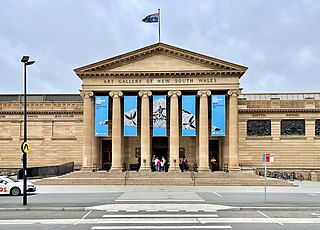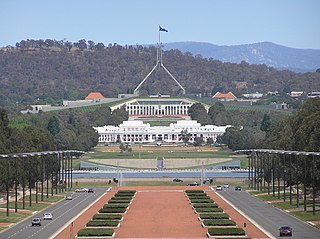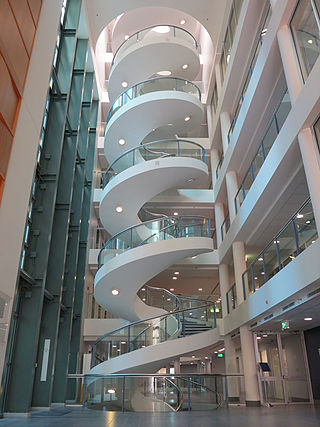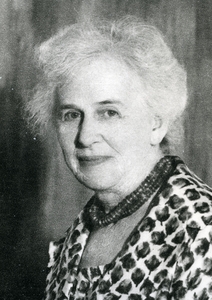
Walter Burley Griffin was an American architect and landscape architect. He is known for designing Canberra, Australia's capital city, the New South Wales towns of Griffith and Leeton, and the Sydney suburb of Castlecrag.

Harry Seidler was an Austrian-born Australian architect who is considered to be one of the leading exponents of Modernism's methodology in Australia and the first architect to fully express the principles of the Bauhaus in Australia.

Marion Mahony Griffin was an American architect and artist. She was one of the first licensed female architects in the world, and is considered an original member of the Prairie School. Her work in the United States developed and expanded the American Prairie School, and her work in India and Australia reflected Prairie School ideals of indigenous landscape and materials in the newly formed democracies. The scholar Deborah Wood stated that Griffin "did the drawings people think of when they think of Frank Lloyd Wright ."
Romaldo "Aldo" Giurgola AO was an Italian academic, architect, professor, and author. Giurgola was born in Rome, Italy in 1920. After service in the Italian armed forces during World War II, he was educated at the Sapienza University of Rome. He studied architecture at the University of Rome, completing the equivalent of a B.Arch. with honors in 1949. That same year, he moved to the United States and received a master's degree in architecture from Columbia University. In 1954, Giurgola accepted a position as an assistant professor of architecture at the University of Pennsylvania. Shortly thereafter, Giurgola formed Mitchell/Giurgola Architects in Philadelphia with Ehrman B. Mitchell in 1958. In 1966, Giurgola became chair of the Columbia University School of Architecture and Planning in New York City, where he opened a second office of the firm. In 1980 under Giurgola's direction, the firm won an international competition to design a new Australian parliament building. Giurgola moved to Canberra, Australia to oversee the project. In 1989, after its completion and official opening in 1988, the Parliament House was recognized with the top award for public architecture in Australia.

The Art Gallery of New South Wales (AGNSW), founded as the New South Wales Academy of Art in 1872 and known as the National Art Gallery of New South Wales between 1883 and 1958, is located in The Domain, Sydney, Australia. It is the most important public gallery in Sydney and one of the largest in Australia.

John Smith Murdoch was a Scottish architect who practised in Australia from the 1880s until 1930. Employed by the newly formed Commonwealth Public Works Department in 1904, he rose to become chief architect, from 1919 to 1929, and was responsible for designing many government buildings, most notably the Provisional Parliament House in Canberra, the home of the Parliament of Australia from 1927 to 1988.

The Australian Institute of Architects is the professional body for architects in Australia. The post-nominals of FRAIA (Fellow) and RAIA continue to be used. The Institute supports 14,000 members across Australia, including 550 Australian members who are based in architectural roles across 40 countries outside Australia. SONA is the national student-membership body of the Australian Institute of Architects.
Colin Frederick Madigan AO was an Australian architect. He is best known for designing the National Gallery of Australia in Canberra.
ARM Architecture or Ashton Raggatt McDougall is an architectural firm with offices in Melbourne, Sydney, and Adelaide, Australia. The firm was founded in 1988 and has completed internationally renowned design work. ARM's founding directors were Stephen Ashton, Howard Raggatt, Ian McDougall.

Daryl Sanders Jackson AO is an Australian architect and the owner of an international architecture firm, Jackson Architecture. Jackson also became an associate professor at University of Melbourne and Deakin University.

Walter Ralston Bunning was a prominent Australian architect and urban planner.

Emil Lawrence Sodersten was an Australian architect active in the second quarter of the 20th century. His work encompassed the Australian architectural styles of Art Deco and Functionalist & Moderne. His design for the Australian War Memorial was "the first national architectural monument in Australia". The Australian Institute of Architects presents the Emil Sodersten Interior Architecture Award annually in his honour.
Robert Raymond (Bob) Woodward was an Australian architect who gained widespread recognition for his innovative fountain designs.

Kenneth Frank Charles Woolley, AM B Arch, Hon DSc Arch Sydney LFRAIA, FTSE, Architect, was an Australian architect. In a career spanning 60 years, he is best known for his contributions to project housing with Pettit and Sevitt, four time Wilkinson Award-winning architect, including three times for his own house, the first being the 1962 Woolley House in Mosman, and his longstanding partnership with Sydney Ancher and Bryce Mortlock. He is regarded as being a prominent figure in the development of the Sydney School movement and Australian vernacular building.
Hassell is a multidisciplinary architecture, design and urban planning practice with offices in Australia, China, Singapore, USA and the United Kingdom. Founded in 1937/8 in Adelaide, South Australia, the firm's former names include Claridge, Hassell and McConnell; Hassell, McConnell and Partners; and Hassell and Partners Pty. Ltd.
Lipson & Kaad was an Australian architectural practice working in Sydney from the 1930s until the 1960s. The partners were Samuel Lipson (1901–1995) and Peter Kaad (1898–1967). In Migrant architects practising modern architecture Rebecca Hawcroft states that "the firm became one of the most successful and prominent in the period and designed several of the era’s best buildings". Both partners were influence by the Amsterdam School and in particular the work of Willem Dudok.
Arthur Baldwinson (1908–1969) was one of Australia's first generation of prominent modernist architects to experience the European modernist movement first hand. His modernist contemporaries include Roy Grounds and Frederick Romberg in Victoria, as well as Sydney Ancher and Walter Bunning in New South Wales; their respective Australian architectural careers in modernism began in the late 1930s. Baldwinson's active professional career as an active practising architect was relatively short (1938–1960).

Ellice Maud Nosworthy was an Australian practising architect for approximately 50 years and graduated as one of Australia's first female architects in 1922.

Peter Kaad (1898–1967) was an Australian architect and a partner in Lipson & Kaad, a practice working in Sydney from the 1930s until the 1960s. His architectural partner was Samuel Lipson (1901–1995). In Migrant architects practising modern architecture Rebecca Hawcroft states that "the firm became one of the most successful and prominent in the period and designed several of the era’s best buildings". Both partners were influence by the Amsterdam School and in particular the work of Willem Dudok.

The MLC Building is a landmark modernist skyscraper in the central business district of North Sydney, on a block bounded by Miller Street, Denison Street and Mount Street. Planned in 1954 and completed in 1957, the complex was designed in the modernist Post-war International style by architects, Bates, Smart & McCutcheon. Its completion marked the appearance of the first high-rise office block in North Sydney and the first use of curtain wall design. Built to provide much-needed office space for the Mutual Life & Citizens Assurance Company Limited, the building continues to be primarily-occupied by its original tenants.


















